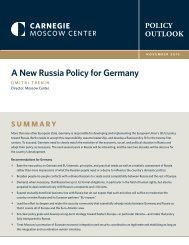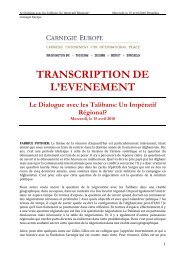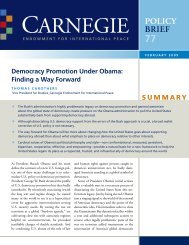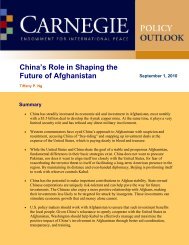An Introduction - Carnegie Endowment for International Peace
An Introduction - Carnegie Endowment for International Peace
An Introduction - Carnegie Endowment for International Peace
You also want an ePaper? Increase the reach of your titles
YUMPU automatically turns print PDFs into web optimized ePapers that Google loves.
20 | democracy challenged<br />
instance, the dominant party managed to block a transfer of power <strong>for</strong><br />
<strong>for</strong>ty years, including a decade when it enjoyed little popularity, but it<br />
also managed to maintain a fairly positive, and gradually improving,<br />
human rights record. All semi-authoritarian regimes take steps to<br />
preserve their core, namely the power ofthe central government,<br />
even ifit means resorting to nondemocratic methods. They differ,<br />
however, in their assessment ofwhat constitutes a dangerous challenge<br />
to that power. As a result, such regimes show a great deal ofvariation<br />
concerning issues such as freedom of the press and individual<br />
liberties. These differences can be quite visible, as the case studies in<br />
the present study show.<br />
Semi-authoritarian regimes also differ in terms of their internal<br />
dynamics and possibilities <strong>for</strong> further change. In this regard, it is possible<br />
to differentiate among three types of semi-authoritarian regimes:<br />
regimes in equilibrium, which have established a balance among<br />
competing <strong>for</strong>ces and are thus quite stable; regimes in decay, where<br />
the authoritarian tendencies appear increasingly strong and the counterbalancing<br />
factors weak, suggesting the possibility that the government<br />
will revert to full authoritarianism; and regimes that are experiencing<br />
dynamic change that may undermine the government’s ability<br />
to maintain the status quo, <strong>for</strong>cing it into opening up new political<br />
space and thus providing the possibility ofincremental progress toward<br />
democracy.<br />
All three types ofsemi-authoritarian regimes have the potential to<br />
become democratic at some point. I am not assuming that democratic<br />
trans<strong>for</strong>mation is impossible anywhere. However, while semi-authoritarian<br />
regimes experiencing dynamic change can become democratic<br />
through incremental change, regimes that are in equilibrium would<br />
have to undergo too stormy an upheaval be<strong>for</strong>e such change could take<br />
place. Decaying regimes are probably those least likely to democratize,<br />
because they are caught in a downward spiral that may lead back to authoritarianism.<br />
The semi-authoritarianism ofequilibrium is the purest <strong>for</strong>m, a stable<br />
condition that has already persisted over a long period and is likely<br />
to continue in the absence ofupheaval. Semi-authoritarian regimes in<br />
equilibrium have proven that they can handle ordinary challenges—<br />
such as the activities ofopposition parties or structural change<br />
brought about by a steady period ofeconomic growth—without a

















